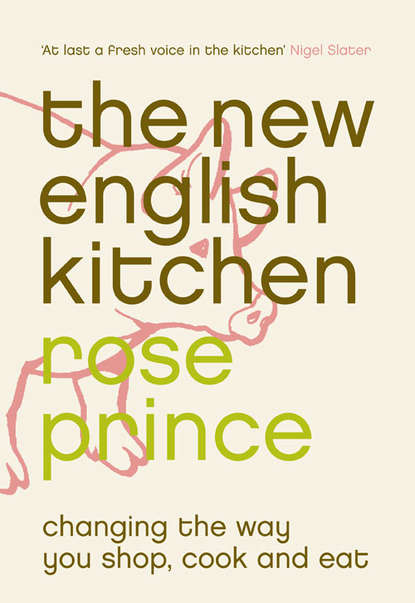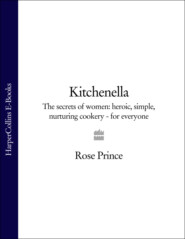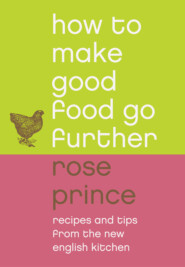По всем вопросам обращайтесь на: info@litportal.ru
(©) 2003-2024.
✖
The New English Kitchen: Changing the Way You Shop, Cook and Eat
Настройки чтения
Размер шрифта
Высота строк
Поля
In a separate bowl, whisk the egg whites with the salt until they form stiff peaks. Fold them into the orange and egg mixture. Butter a 20cm/8 inch round cake tin – use up all the butter; when it cooks it will be absorbed into the cake and form a delicious crust. Pour in the mixture and bake for 50 minutes, until the cake has shrunk from the side of the tin and feels springy when you press the surface with a finger. Unmould the cake and cool on a wire rack. Dust with icing sugar.
2 store (#ulink_5c9e82ce-5148-5f46-b6ce-84388bb02cc5)
A good cook knows how to squirrel food away, storing it to save not just time but money, too. Squirrelling reduces the number of occasions when you hear yourself say, ‘I haven’t the time to cook.’ It is also a comfort when you don’t want to shop. It’s not that taking an evening off cooking is a bad thing, but with the pressure upon everyone to work longer hours and spend more time on other pursuits, a night off cooking can turn into six nights. And unless you really hate cooking, it’s not just the cost that is irksome but the sensation that you are 100 per cent reliant on others to choose the food you eat.
A good store of food not only means more home cooking and therefore more pleasure, it makes good economic sense, rewarding you with more money to spend on other things.
A few organisational skills are needed. Briefly imagine living on a boat. The bulk of what you eat must come from packets, cans, or sacks kept in the dark to prevent the contents rotting. Before the days of fridge freezers, the ship’s cook must have been a man of talent, able not only to improvise with the few fresh ingredients available but – who knows? – perhaps also to prevent a crew going stir-crazy from meal tedium. Knowing how to use your stores is a good discipline. Even with the advantages of refrigerated storage, store food has changed little from centuries ago.
The miles of aisles devoted to bottled, canned, frozen and packet food are endless. Spoilt for choice, that’s us – yet look again and there are very few things that anyone really needs. Cooking sauce? Try a little oil, spice and lemon. Flavoured rice? Add dried wild mushrooms to ordinary rice. Ready-made vegetable curry? Heat canned tomatoes, coconut milk and spices with canned chick peas.
Food manufacturers are always keen to show journalists their latest innovations. Warrens of laboratories are devoted to the imaginings of their development teams. In the name of convenience, they bottle and preserve our favourite foods and create some weird new ones. My heart sinks when I see all this effort in pursuit of the impossible. Fresh pesto tickles every sense; bottled is, well, all right. Home-made tomato sauce is sweet, light and delicate; commercially bottled tomato sauce is salty and acidic, bulked out with thickeners to make money for the manufacturer. None of these is essential. Lazy cooks could save themselves the bother of carrying it all home if only they would shake a little good olive oil on to cooked pasta, chop a bit of chilli and mash a little garlic. This is olio d’aglio – the sauce to make when you come in at midnight, desperate not just for food but for real cooking.
The contents of my store cupboard are minimal. Actually, that’s not entirely true. The contents of my store cupboard are vast, but most of it is food bought that is never finished. No matter how clever the manufacturer, I don’t want their poppy seed, tarragon and lemon salad dressing – I want my bottle of olive oil and a lemon, and a little soft crystal sea salt. The contents of my store cupboard that I use are minimal. That is the truth.
This is about the sum of it. I could potentially survive on the following but the children would complain:
dried foods
Grains – Rice, couscous, bulgar, hulled durum wheat.
Dried pulses – Green lentils, including Puy, and red lentils.
Cans – Tomatoes, coconut milk, artichokes in brine; beans (cannellini, flageolet, butter beans) and chick peas; plus there’s always a tin of dried Colman’s mustard powder, ready to mix with water to eat beside Saturday breakfast chipolata sausages.
Bottles – French mustard, capers and gherkins.
Packets – Flours – strong white and wholemeal, plain and self raising plus some alternative flours like gram and potato flour; pasta – both long and short durum wheat pasta, and nests of noodles made with egg; sugar – unrefined caster and soft brown; spices, seeds (sesame and pumpkin), dried fruit (figs, prunes, sultanas), pine nuts and pistachios.
Fruit and vegetables – Oranges and lemons, potatoes, garlic, shallots and onions.
Finally, by the hob, there are two bottles of olive oil – standard and good – plus sesame oil, avocado oil (both good wok oils), soy sauce, red wine vinegar and rice vinegar.
the fridge
Fats – Butter, dripping, coconut cream and duck fat.
Dry-cured meat – bacon, ham, salami and chorizo.
Fresh herbs and salad leaves – wrapped in damp newspaper these keep a long time.
the freezer
Meat – A variety of cuts, plus sausages and chicken (see the chapters on meat and poultry).
Stock – frozen in plastic bottles.
Seafood – Atlantic prawns and squid.
Bought pastry, breadcrumbs.
Fruit and vegetables – red berries, plus oddities like stewed quince and rhubarb, peas and broad beans, and invaluable cooked tomato sauce.
The dried foods listed above are items that have, more or less, been in store cupboards for ever. The important thing is to put them into a modern context, making them fit the life you lead now. It isn’t necessary to buy 50 different foods a week. Just a few will do, each put to more than one use. Look at what is fresh in the house, or what can be bought at the shop you pass on the way home. Can it be used with one of your store foods? The shop has spring onions, you have some eggs, frozen peas, and cooked rice left over from last night. A bowl of fried rice is yours, and very good it can be.
cooked store foods
There is a group of storable foods that, since they are already cooked, can be swiftly added to something else for an almost-instant meal. Leftover rice; tomatoes simmered until sweet with oil; mashed potato; braised lentils; meat sauce, and stock – these are the things that really do save time shopping and cooking, while simultaneously helping to provide the home cooking that everyone craves deep down.
food-safety rules
Modern food-safety advice can be the enemy of good home economics. It encourages wastefulness and, worse, it promotes the idea of microwaving chilled or frozen food in sealed containers. Talk of reheating food is viewed by the food-safety authorities as subversive stuff – dangerous talk perverting the nanny state’s plan to make all food safe. But there’s no hope of making all food safe. Not when 60 million humans are on the loose – eating dirt as babies, sharing dinners with family pets as toddlers. Who hasn’t occasionally sampled the glory of a dropped 99 ice cream with its topping of earth and grass, or gallantly rescued a dusty boiled sweet from under the sofa? And in adulthood there are all sorts of opportunities to eat living food, as you begin to enjoy handmade cheeses, air-dried meat and reheated leftovers.
The thing to bear in mind is that the most dangerous thing about food is the person handling it. If you store and reheat food, use your common sense, and your senses. Keep cooked food in clean, sealed containers in the fridge and check it for signs of deterioration in terms of appearance and smell. Always make sure you reheat food thoroughly before use, and the risk to anyone who’s had that dirt-eating, droppedlolly childhood should be low.
rice
I recommend deliberately cooking more long grain or basmati rice than you need. Kept in a sealed container in the fridge, it yields almost-instant meals throughout the week: reheated into a pilaff with meat or vegetables; stir-fried with peas; or stirred into lemongrass-infused coconut milk. Short grain or risotto rice can be partly cooked, then stored to make into quick risottos; any leftover risotto can be rolled into balls, crumbed, fried and eaten with green salad.
rice economics
The value of rice – and all grains, beans and pulses, for that matter – lies in its ability to provide a cheap, meatless meal. Once you accept the principle that more must be paid for better meat, inexpensive foods such as rice become essential. A kilo of good-quality basmati rice should cost around £2.75, while Arborio rice will be about £4. They will yield 20 servings of 50g, each serving costing 14 pence and 20 pence respectively. The cost of added fat, vegetables, herbs and spices is minimal, so this is great food, economically and gastronomically.
buying rice
To make it easy, I buy just two types of rice: genuine long grain basmati from India or Pakistan, and Italian short grain rice, usually Arborio but I have also made short grain rice dishes with Carnaroli, Spanish paella rice and even ‘pudding rice’, which works magnificently in emergencies.
Basmati rice is grown in the foothills of the Himalayas, in both India and Pakistan. It is the rice I eat plain with curries and sometimes with fish, or make into pilaffs and re-fry in a pan. Good basmati lengthens to almost twice its size when cooked, so it is worth paying for the best. Choose genuine brands, labelled ‘pure’ basmati, rather than the cheaper, inferior hybrids, which do not lengthen in the same way.
Asian stores and some supermarket delivery services sell 5-kilo bags of pure basmati rice. They have nylon zips so they can be properly sealed to keep out bugs and mites, which is very important. A bag of this size costs approximately £10, bringing the price of one helping of best basmati rice down to 10 pence.
American long grain rice is the other choice. But, while it is cheaper and meatier, it does not have the elegant scent of basmati or its enjoyable texture in the mouth.
Short grain rice is used for risotto and rice puddings. It can absorb twice or more of its weight in liquid, and should retain a tiny opaque pearl of hardness in the centre when perfectly cooked. There are many brands, most of which perform their task well, but makers of specialist varieties from Italy or Spain will wax on about their superiority – which is, in my view, less obvious than it is with genuine basmati.
to cook basmati or long grain white rice
The following method should solve your rice troubles, but given time you will instinctively know when to turn off the heat, how long to leave the lid on, and so on. I like to wash and soak the rice first, as it shortens the cooking time by a few minutes and also helps to produce perfectly cooked, unbroken grains. However, you can omit this procedure if you prefer.
Serves 4–8, depending on appetite
480g/1 lb long grain white rice
600ml/1 pint water
To wash the rice, place it in a saucepan, fill the pan with water, then swirl the rice around a bit to release the starch. Carefully pour most of the water away, leaving the rice in the pan. Repeat twice, then cover the rice with water again and leave to soak for a minimum of 15 minutes.
Drain the rice in a sieve, then return it to the pan and add the 600ml/l pint of water. Bring to the boil, stirring once. Let the rice simmer, uncovered, for about 10 minutes, until all the water has been absorbed, then cover the pan with a well-fitting lid – put foil between the lid and the pan if it is loose. You do not want the vapour to escape. Turn the heat down very low and continue to cook for 5–7 minutes. Turn off the heat and leave the rice for a further 5 minutes, without removing the lid. Fork the rice to loosen the grains and it is ready to eat.









